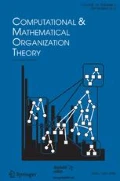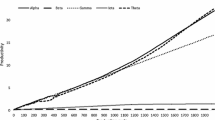Abstract
Modern knowledge-intensive economies are complex social systems where intertwining factors are responsible for the shaping of emerging industries: the self-organising interaction patterns and strategies of the individual actors (an agency-oriented pattern) and the institutional frameworks of different innovation systems (a structure-oriented pattern). In this paper, we examine the relative primacy of the two patterns in the development of innovation networks, and find that both are important. In order to investigate the relative significance of strategic decision making by innovation network actors and the roles played by national institutional settings, we use an agent-based model of knowledge-intensive innovation networks, SKIN. We experiment with the simulation of different actor strategies and different access conditions to capital in order to study the resulting effects on innovation performance and size of the industry. Our analysis suggests that actors are able to compensate for structural limitations through strategic collaborations. The implications for public policy are outlined.
Similar content being viewed by others
References
Amable B (2003) The diversity of modern capitalism. Oxford University Press, Oxford
Argyris C, Schoen DA (1996) Organisational learning: a theory of action perspective. Addison-Wesley, Reading
Beije P (1998) Technological change in the modern economy: basic topics and new developments. Elgar, Cheltenham
Bolton GE, Katoka E, Ockenfels A (2005) Cooperation among strangers with limited information about reputation. J Public Econ 89:1457–1468
Bourdieu P (2005) The social structures of the economy. Polity Press, Cambridge
Bourdieu P (1992) The logic of fields. In: Bourdieu P, Wacquant L (eds) An invitation to reflexive sociology. University of Chicago Press, Chicago, pp 94–114
Brusoni S, Prencipe A, Pavitt K (2001) Knowledge specialisation, organizational coupling and the boundaries of the firm: why firms know more than they make? Adm Sci Q 46:597–621
Cantner U, Pyka A (1998) Absorbing technological spillovers. Simulations in an evolutionary framework. Ind Corp Change 7(2):369–397
Cohen WM, Levinthal D (1989) Innovation and learning: the two faces of R&D. Econ J 99:569–596
Casper S, Kettler H (2001) National institutional frameworks and the hybridization of entrepreneurial business models: the German and UK biotechnology sectors. Ind Innov 8:5–30
Casper S, van Waarden F (2006) Innovation and institutions. A multi-disciplinary review of the study of innovation systems. Elgar, Cheltenham
Collins HM (1995) Science studies and machine intelligence. In: Jasanoff S, Markle GE, Petersen JC, Pinch T (eds) Handbook of science and technology studies. Sage, Thousand Oaks, pp 286–301
Commission of the European Communities (2002) Benchmarking national R&D policies: first results. Commission Staff Working Paper, Brussels SEC 129
Cooke P, Morgan K (1998) The associational economy, firms, regions and innovation. Oxford University Press, Oxford
de Geus A (1997) The living company. Brealy, London
Dewey J (1938) Experience and education. Collier, New York
Duncan RB (1974) Modifications in decision structure in adapting to the environment: some implications for organizational learning. Decis Sci 5:705–725
Eliasson G (1995) General purpose technologies, industrial competence and economic growth. Working Paper, Royal Institute of Technology, Stockholm
Feldman M, Francis J, Bercovitz J (2005) Creating a cluster while building a firm: entrepreneurs and the formation of industry clusters. Reg Sci 39:129–142
Garcia R, Dunn DT, Smith LA (forthcoming a) Boundary spanners and social networks surrounding research centers. NSF 04-556 Partners for Innovation Program. Working Paper
Garcia R, Dunn DT, Smith LA (forthcoming b) Performance of knowledge interactions between public research centres and industrial firms: an application for Spanish public research centres based on project-level data. Working Paper
Granovetter M (1985) Economic action and social structure: the problem of embeddedness. Am J Soc 91:481–510
Hall P, Soskice D (eds) (2001) Varieties of capitalism. Oxford University Press, Oxford
Hedberg B (1981) B. Hedberg, How organizations learn and unlearn. In: Nystrom PC, Starbuck WH (eds) Handbook of organizational design. Oxford University Press, Oxford
Knight FH (1921) Risk, uncertainty and profit. Chicago
Lisbon Agenda Group (2007): http://www.mariajoaorodrigues.eu/lisbon-agenda/group/
Malerba F, Nelson R, Orsenigo L, Winter S (1999) History friendly models of industry evolution: the computer industry. Ind Corp Change 8:3–40
Malerba F (2002) Sectoral systems of innovation and production. Res Policy 31:247–264
Michael DM (1973) On learning to plan and planning to learn. Jossey-Bass, Hoboken
Michelet R (1992) Forming successful strategic marketing alliances in Europe. J Eur Bus 4:11–15
Pavitt K (1987) The objectives of technology policy. Sci Public Policy 14:182–188. Reprinted in Pavitt (1999)
Petit P, Amable B (2001) The diversity of social systems of innovation and production during the 1990s. Working Paper CEPREMAP # 2001 – 15
Powell WW, White DR, Koput KW, Owen-Smith J (2005) Network dynamics and field evolution: the growth of inter-organizational collaboration in the life sciences. Am J Soc 110:1132–1205
Pyka A, Kueppers G (eds) (2003) Innovation networks—theory and practice. Edward Elgar, Cheltenham.
Pyka A, Saviotti PP (2003) Innovation networks in the biotechnology-based industries. In: Pyka A, Kueppers G (eds) Innovation networks - theory and practice. Edward Elgar, Cheltenham, pp 75–107
Pyka A, Saviotti PP (2005) The Evolution of R&D networking in the biotech industries. Int J Entrepreneurship Innov Manag 5(1/2):49–68
Weber M (2003) Innovation networks and the transformation of large socio-technical systems: the case of combined heat and power technology. In: Pyka A, Kueppers G (eds) Innovation Networks - Theory and Practice. Edward Elgar, Cheltenham, pp 133–165
Windrum P (2003) The role of knowledge-intensive business services (KIBS) in e-commerce. In: Pyka A, Kueppers G (eds) Innovation networks - theory and practice. Edward Elgar, Cheltenham, pp 108–132
Winter SG (1984) Schumpeterian competition in alternative technological regimes. J Econ Behav Organ 5:237–261
Author information
Authors and Affiliations
Corresponding author
Rights and permissions
About this article
Cite this article
Ahrweiler, P., Gilbert, N. & Pyka, A. Agency and structure: a social simulation of knowledge-intensive industries. Comput Math Organ Theory 17, 59–76 (2011). https://doi.org/10.1007/s10588-010-9081-3
Published:
Issue Date:
DOI: https://doi.org/10.1007/s10588-010-9081-3




